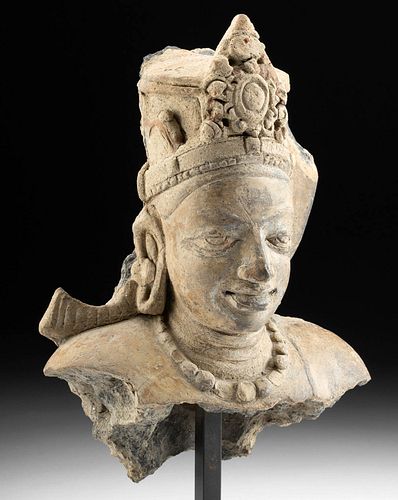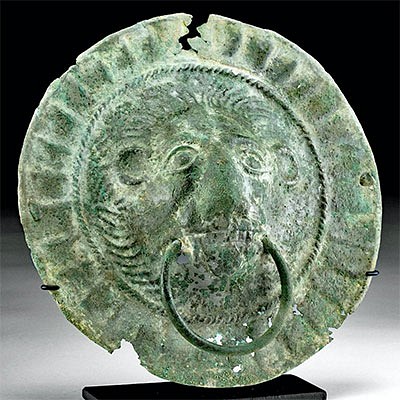Indian Kushan Fragment of Vishnu Bust
Lot 75
About Seller
Artemis Fine Arts
686 S Taylor Ave, Ste 106
Louisville, CO 80027
United States
Selling antiquities, ancient and ethnographic art online since 1993, Artemis Gallery specializes in Classical Antiquities (Egyptian, Greek, Roman, Near Eastern), Asian, Pre-Columbian, African / Tribal / Oceanographic art. Our extensive inventory includes pottery, stone, metal, wood, glass and textil...Read more
Categories
Estimate:
$5,000 - $7,500
Absentee vs Live bid
Two ways to bid:
- Leave a max absentee bid and the platform will bid on your behalf up to your maximum bid during the live auction.
- Bid live during the auction and your bids will be submitted real-time to the auctioneer.
Bid Increments
| Price | Bid Increment |
|---|---|
| $0 | $25 |
| $300 | $50 |
| $1,000 | $100 |
| $2,000 | $250 |
| $5,000 | $500 |
| $10,000 | $1,000 |
| $20,000 | $2,500 |
| $50,000 | $5,000 |
| $100,000 | $10,000 |
| $200,000 | $20,000 |
About Auction
By Artemis Fine Arts
Oct 14, 2021
Set Reminder
2021-10-14 10:00:00
2021-10-14 10:00:00
America/New_York
Bidsquare
Bidsquare : CLEARANCE | Ancient & Ethnographic Art
https://www.bidsquare.com/auctions/artemis-gallery/clearance-ancient-ethnographic-art-7705
Kick off fall with our clearance sale featuring discounted pricing and many new items! Asian art, Classical antiquities from Egypt, Greece, Italy, and the Near East...plus Pre-Columbian, Tribal, Russian Icons & Enamelware, Spanish Colonial, Fine Art, Fossils, more! Starting prices have been reduced Artemis Fine Arts info@artemisgallery.com
Kick off fall with our clearance sale featuring discounted pricing and many new items! Asian art, Classical antiquities from Egypt, Greece, Italy, and the Near East...plus Pre-Columbian, Tribal, Russian Icons & Enamelware, Spanish Colonial, Fine Art, Fossils, more! Starting prices have been reduced Artemis Fine Arts info@artemisgallery.com
- Lot Description
**Originally Listed At $3500**
South Asia, Northwestern India, Kushan Empire, ca. 3rd to 4th century CE. A Kushan terracotta bust of Vishnu, one of the principal deities of Hinduism, known as the preserver in the Hindu trinity (Trimurti) which also includes Brahma and Shiva. The deity looks forward with elegant features and is bedecked with a beaded necklace and a tall miter that is elaborately bejeweled and adorned with a central floral motif. One can also see the remains of his nimbus surrounding his visage. A fine rendering of Vishnu, revered for restoring order and combatting evil in order to maintain harmony and balance in the universe. Size: 5.1" W x 6.7" H (13 cm x 17 cm); 8.8" H (22.4 cm) on included custom stand.
The Kushan Empire controlled part of the Silk Road between China and the Mediterranean, and its position as a crossroads led to the creation of a dynamic fusion culture. Sculptures like this one give us a hint to the elaborate clothing and personal ornamentation that elite people wore during this period. Most articles of Kushan clothing were heavily decorated with metal plaques and beads.
Provenance: private New Jersey, USA collection, acquired 2015
All items legal to buy/sell under U.S. Statute covering cultural patrimony Code 2600, CHAPTER 14, and are guaranteed to be as described or your money back.
A Certificate of Authenticity will accompany all winning bids.
PLEASE NOTE: Due to recent increases of shipments being seized by Australian & German customs (even for items with pre-UNESCO provenance), we will no longer ship most antiquities and ancient Chinese art to Australia & Germany. For categories of items that are acceptable to ship to Australia or Germany, please contact us directly or work with your local customs brokerage firm.
Display stands not described as included/custom in the item description are for photography purposes only and will not be included with the item upon shipping.
#161184A fragment of a larger pottery bust as shown. Fragment is adhered to display stand and cannot be removed. Repairs to left shoulder, bottom-right area of verso, and areas of underside, with chips and light adhesive residue along break lines. Losses to areas of crown, finery, coronal halo, and lower body beneath clavicle and shoulders. Encrustations within several areas, with fading to original pigment. Wonderful preservation of facial details.Condition
- Shipping Info
-
All shipping is handled in-house for your convenience. Your invoice from Artemis Gallery will include shipping calculation instructions. If in doubt, please inquire BEFORE bidding for estimated shipping costs for individual items.
-
- Buyer's Premium



 EUR
EUR CAD
CAD AUD
AUD GBP
GBP MXN
MXN HKD
HKD CNY
CNY MYR
MYR SEK
SEK SGD
SGD CHF
CHF THB
THB














